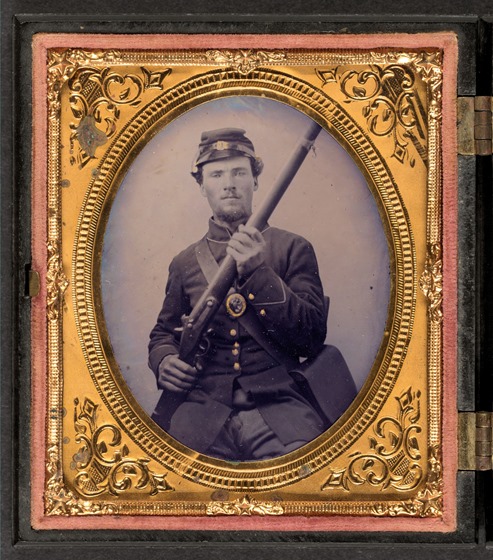
Private Jacob Harker of Company C, 120th Ohio Volunteers in uniform with musket and haversack; identification based on note inside case: Pvt. Jacob Harker, Co. C, 120th Ohio Vol. died May 1863 of diarrhea, N.O., La.
sixth-plate tintype, hand-colored ; 9.5 x 8.3 cm (case)
Donated by Tom Liljenquist; 2012
Liljenquist Family Collection of Civil War Photographs; Ambrotype/Tintype photograph filing series; Library of Congress Prints and Photographs Division.
Record page for image is here.
__________
 Note – This image has been digitally adjusted for one or more of the following:
Note – This image has been digitally adjusted for one or more of the following:
- fade correction,
- color, contrast, and/or saturation enhancement
- selected spot removal.
Civil War Portrait 032

“Head-Quarters Major-General McPherson, May 13, 1863
“At 10 o’clock on the 12th the ‘Body Guard,’ under Captain Foster, discovered the enemy in small force upon the road three miles from Raymond. A portion of General Dennis’s brigade—the Twentieth Ohio and Thirtieth Illinois Regiments —were deployed to the right and left of the road. Being advanced, the enemy were discovered in line of battle, occupying a commanding position, a mile and a half from Raymond.
“A section of De Golyer’s battery was placed in position in the road, and at a distance of one thousand yards opened the fight, when the whole battery was placed in position, with the brigade of General Dennis for its support, it being in turn supported by the brigades of Generals Smith and Stevenson, who soon after formed in line of battle upon the right. These troops, constituting General Logan’s division, were soon charged by the enemy. The charge was upon the right flank, but the previous disposition of troops frustrated it, and a sharp engagement of an hour ensued. The enemy were repulsed.
“General Crocker’s division coming up, was disposed to the right, left, and reserve by General McPherson, and the line immediately advanced. The rebels, being driven from their position, retreated through the town toward Jackson. and our troops occupied Raymond. Our loss was 52 killed and 198 wounded. Among the killed was Coloneel Richards. Colonel McCook was wounded.

Study of infantry soldier on guard–William J. Jackson, Sergt. Maj. 12th N.Y. Vols.–Sketched at Stoneman’s Switch, near Fredricksburg, Va. Jan. 27th, 1863.
Drawn by Edwin Forbes.
Library of Congress image.
___________
 Note: This image has been digitally adjusted for fade correction, color, contrast, and saturation enhancement and selected spot removal.
Note: This image has been digitally adjusted for fade correction, color, contrast, and saturation enhancement and selected spot removal.
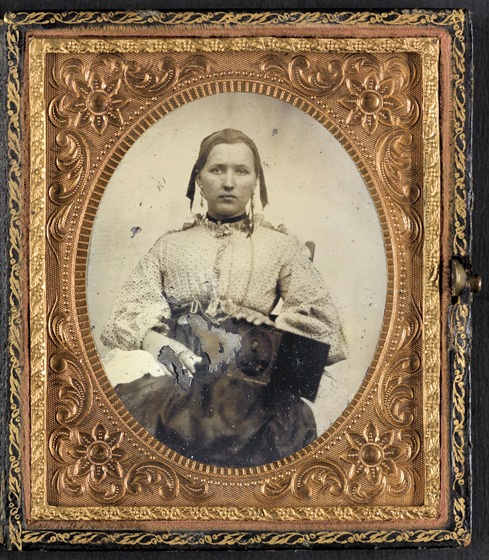
Unidentified woman with cased photograph of Private W.R. Clack Co. B, 43rd Tennessee Infantry Regiment, possibly Clack’s future wife, Sabria Caroline Newport Clack. They married after the war.
half-plate ambrotype, hand-colored ; 15.7 x 12.7 cm (case)
Donated by Tom Liljenquist; 2012
Liljenquist Family Collection of Civil War Photographs; Ambrotype/Tintype photograph filing series; Library of Congress Prints and Photographs Division.
Record page for image is here.
______________
 Note: This image has been digitally enhanced for fade correction, color enhancement and selected spot removal.
Note: This image has been digitally enhanced for fade correction, color enhancement and selected spot removal.
Civil War Portrait 031
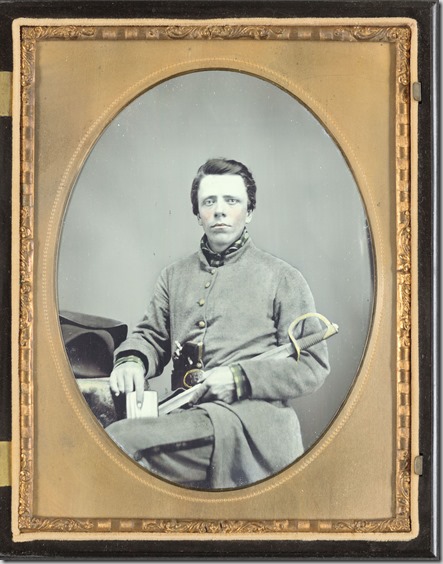
On May 10, 1863, Private Clack is on picket or fortification duty near Big Black River in Mississippi, outside of the Vicksburg fortifications.
__________
Private W.R. Clack of Co. B, 43rd Tennessee Infantry Regiment, with saber, pistol, and small book.
half-plate ambrotype, hand-colored ; 15.7 x 12.7 cm (case)
Donated by Tom Liljenquist; 2012
Liljenquist Family Collection of Civil War Photographs; Ambrotype/Tintype photograph filing series; Library of Congress Prints and Photographs Division.
Record page for image is here.
______________
 Note: This image has been digitally enhanced for fade correction, color enhancement and selected spot removal.
Note: This image has been digitally enhanced for fade correction, color enhancement and selected spot removal.
Civil War Portrait 030
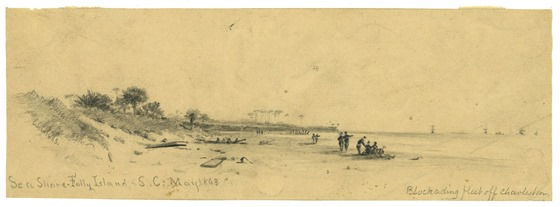
Sea Shore – Folly Island, S.C. May 1863
Artist – Alfred R. Waud; drawing on cream paper : pencil ; 6.7 x 19.0 cm. (sheet).
Inscribed lower right: Blockading fleet off Charleston.
Library of Congress image.
__________
The only actual fighting to occur on Folly Island was on May 10th, 1863, when confederate forces attacked federal pickets on the left side of Little Folly Island. The fighting was light, as the confederate forces were conducting a reconnaissance mission, aimed mostly at gathering information and taking prisoners. (Source: An Educators Guide to Folly Island, South Carolina.)
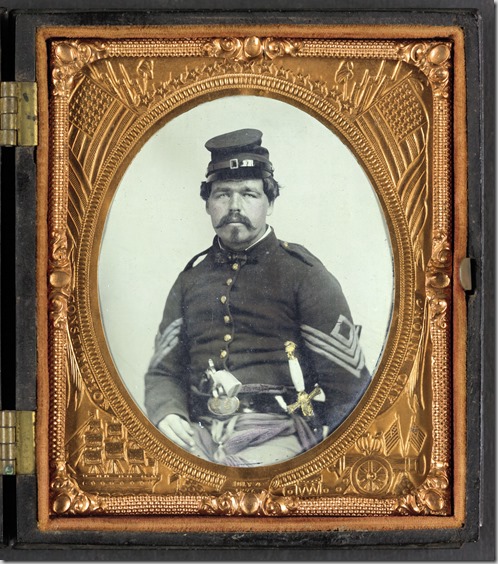
Unidentified soldier in Union first sergeant’s uniform with militia sword and revolver.
sixth-plate tintype, hand-colored ; 9.5 x 8.2 cm (case)
Donated by Tom Liljenquist; 2012
Liljenquist Family Collection of Civil War Photographs; Ambrotype/Tintype photograph filing series; Library of Congress Prints and Photographs Division.
Record page for image is here.
______________
 Note: This image has been digitally enhanced for fade correction, color enhancement and selected spot removal.
Note: This image has been digitally enhanced for fade correction, color enhancement and selected spot removal.
Civil War Portrait 029
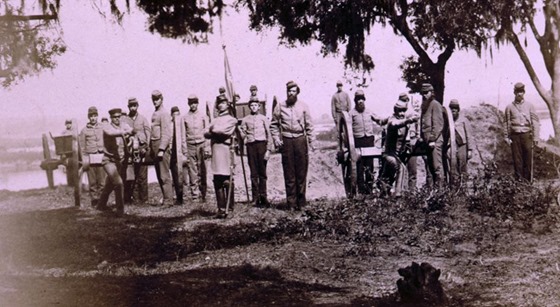
Confederate artillery near Charleston, S.C.
Photographer: George Smith Cook.
Caption log entry for no. 10358: Palmetto Battery, near Charleston, S.C. Photo by Cook.
Library of Congress image.
_______
(In 1863, Cook) took family and studio and left Charleston to relocate “in a place safe from military action. He chose a site near the state capital, Columbia, where there would be no danger of invasion by sea. .. By the morning of February 19, 1865 the city was a mass of smoldering ruins. .. Cook’s temporary gallery was in the path of the flames and all of his equipment, his work and his records were destroyed. .. [Source: Geo. S. Cook – Studios]
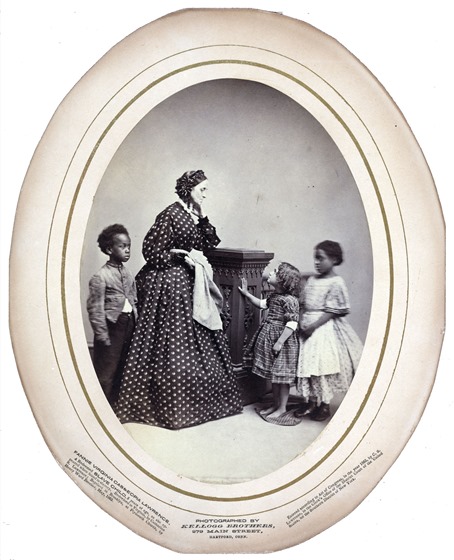
Fannie Virginia Casseopia Lawrence, a redeemed slave child, five years of age as she appeared when found in slavery. Redeemed in Virginia by Catharine [i.e., Catherine] S. Lawrence; baptized in Brooklyn, at Plymouth Church by Henry Ward Beecher, May 1863 / photographed by Kellogg Brothers, 279 Main Street, Hartford Conn.
Fannie was one of the most photographed of “slave children” used as propaganda by abolitionists during the civil war. Despite her light color, she was considered black because of mixed black.white ancestry. Fannie was considered an “octoroon”as someone who was of 1/8 black ancestry.
Henry Ward Beecher, of course, was one of the leading abolitionist spokesmen in the U. S., a preacher and brother of Harriet Beecher Stowe, author of “Uncle Tom’s Cabin.
Civil War Portrait 028
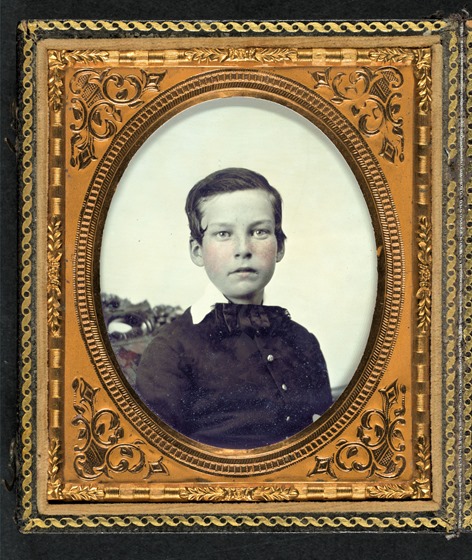
Private Charles H. Bickford of B Company, 2nd Massachusetts Infantry Regiment as a child.
Name from inscription on handwritten note in case; additional information on note includes date of birth, March 1844, date and place of death, May 3, 1863, at Chancellorsville, Virginia, and name of sister, Georgeanna Hunt.
Gift; Tom Liljenquist; 2010
Liljenquist Family Collection of Civil War Photographs; Ambrotype/Tintype photograph filing series; Library of Congress Prints and Photographs Division.
Record page for image is here.
Civil War Portrait 027
 Note – This image has been digitally adjusted for one or more of the following:
Note – This image has been digitally adjusted for one or more of the following:














